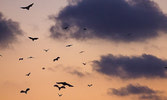Afraid of bats? Admire and protect them instead


Bats significantly assist us because they eat half their weight in insects, including mosquitoes after their dormancy during winter. They also help pollinate and fertilize crops.
Bats locate their food using echolocation, meaning that they emit a high-frequency sound and monitor the returning sound waves to determine the size and location of their prey. When we consider their prey is a small flying insect, these mammals’ echolocation and acrobatic capabilities are truly astonishing.
But bats – particularly the Little Brown Bat – are endangered now, because of White Nose Syndrome (Pseudogymnoascus destructans), a fungus that’s killed more than 5.7 million bats in North America. Because of this staggering population decline, WNS earns the reputation of being one of the world’s worst wildlife diseases of modern times.
Little Brown Bat
One of 19 bat species in Canada, the little brown bat is 8-10 cm long, weights 7-9 grams, and has a wingspan of 25-27 cm. (Nature Conservancy of Canada: bit.ly/3Q11o3i) Its range includes most of Quebec, where the only provinces and territories in Canada in which it doesn’t exist are PEI, Nova Scotia, Newfoundland (they exist in parts of Labrador) and Nunavut.
Female Little Brown bats help with insect management more than the males because they eat more than their body weight in insects when feeding their pups.
Where did WNS come from?
Its origin remains unknown.
The fungus was first seen on bats (as a white, powder-like “dust” on their muzzles) in 2006 in New York State.
Is WNS always a killer?
After its discovery in North America, scientists discovered it in Asia and Europe, where for some reason bats don’t succumb to it quite as much.
Here in North America, however, some roosting sites have been 90-100 percent eradicated by WNS. (whitenosesyndrome.org)
On its website, the Nature Conservancy of Canada explains how WNS affects bats: “This fungus thrives in cool, moist environments and infects the exposed skin of the muzzle and wings of hibernating bats. It causes bats to use more energy than they can afford during hibernation and to wake up more frequently than healthy bats, usually leading to death.”
Helping bats
Scientists are trying to develop a vaccine to help dwindling populations survive WNS infection.
In addition, research is being conducted on how to change and improve bat habitats.
As a researcher from the Canadian Wildlife Federation (CWF) told CBC Ottawa Morning radio host on August 4, there’s little point in purchasing bat boxes for the mammals to roost in, if they’re unsuitable. Researchers from the CWF were heading out to band bats at the Macskimming Outdoor Education Centre that day so that, among other research, they can identify where bats actually are roosting so that better bat boxes can be constructed.
Building bat houses
Meanwhile, if you’re interested in building bat boxes, the CWF offers free downloadable plans on how to construct them at: bit.ly/3SobtsB.
Purchasing bat houses:
What to look for
The CWF website (bit.ly/3Qh1ELc) presents tips regarding a well-built bat house:
“Like us, they don’t want leaky roofs, but they do need some airflow coming in from air vents on the sides. In northern climates like Canada, bats prefer a house that warms up quickly, especially for maternity roosts. That means using dark wood or dark non-toxic paint, easily warmed by the sun. And just like their human counterparts, it’s all about location!”
Do what we can
Bats need protection and often, we can help. Perhaps the biggest help? Explain to your kids that bats help us control mosquitoes and other insects – in the ultimate “natural way” using that fascinating echolocation capability.
Katharine Fletcher is a freelance writer, author, and visual artist. Contact her: fletcher.katharine@gmail.com and view her art at facebook.com/KatharineFletcherArtist/


